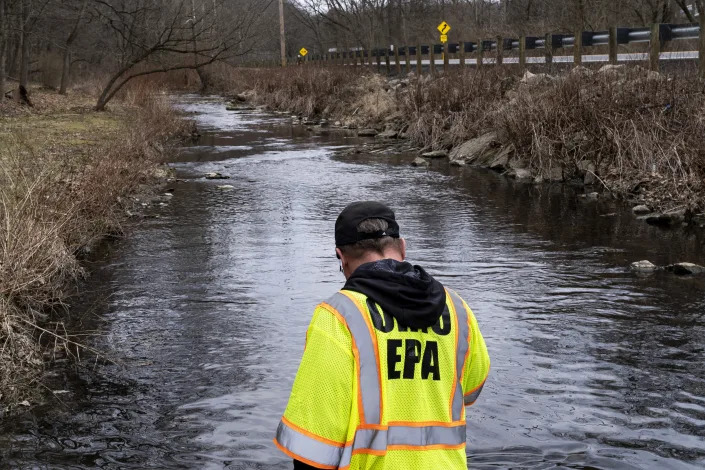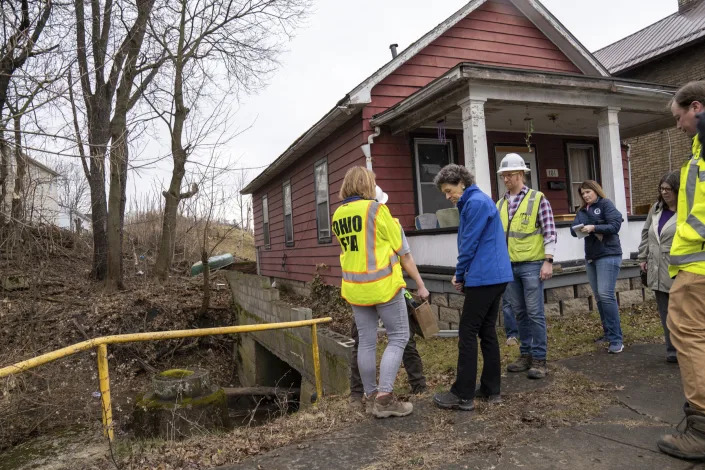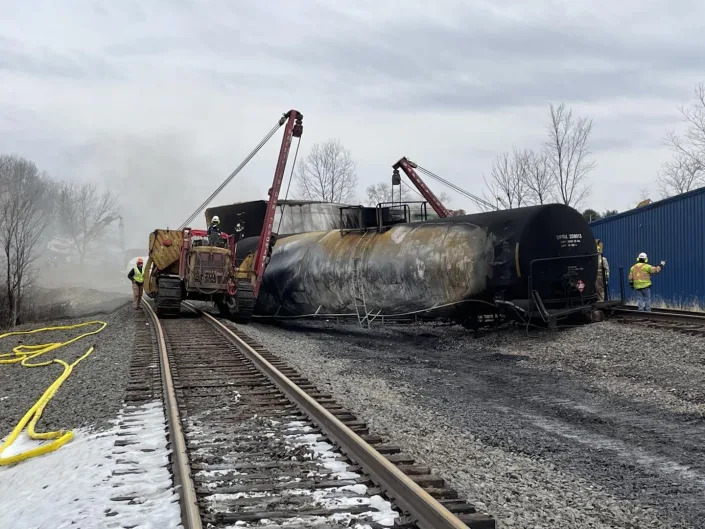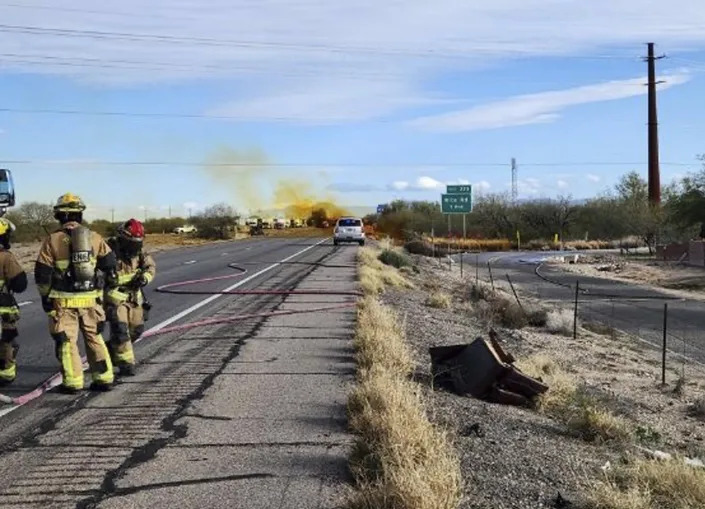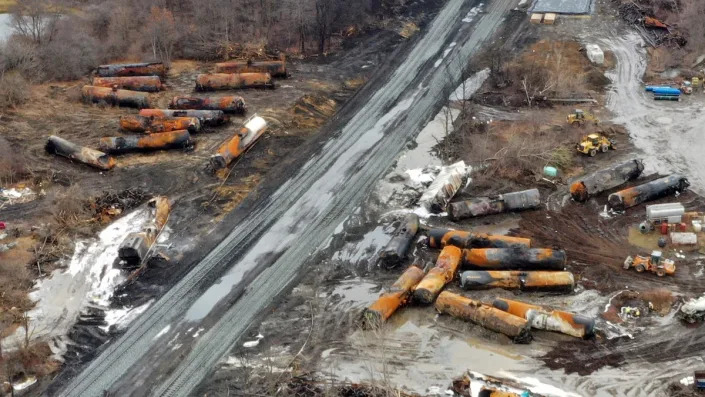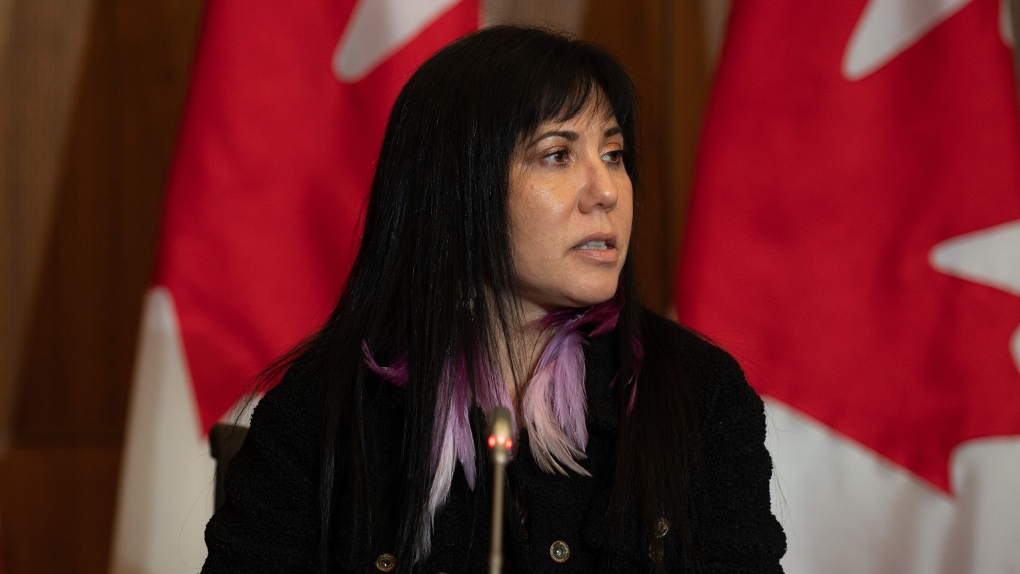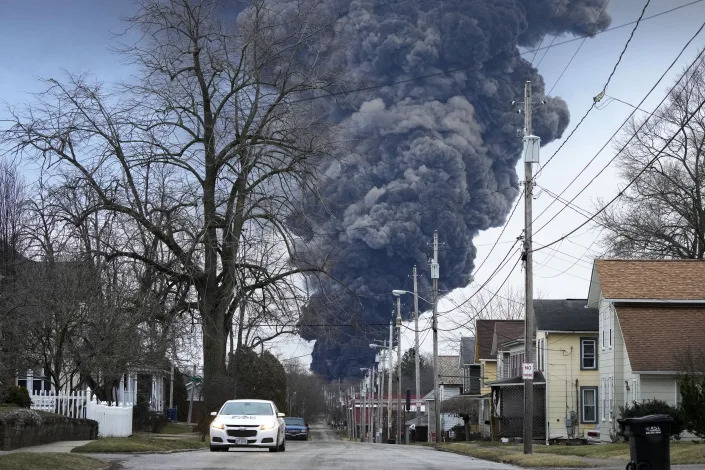
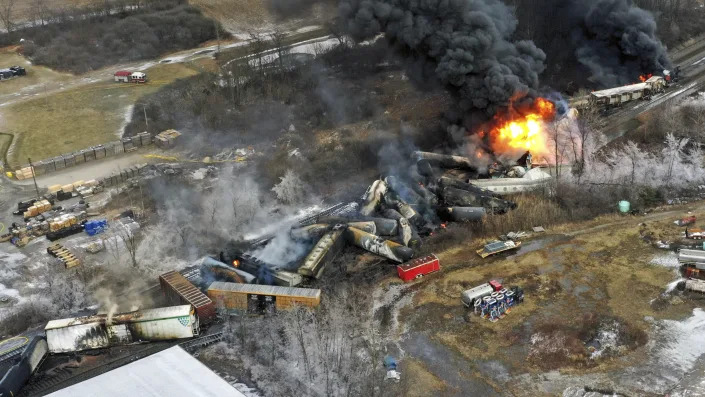
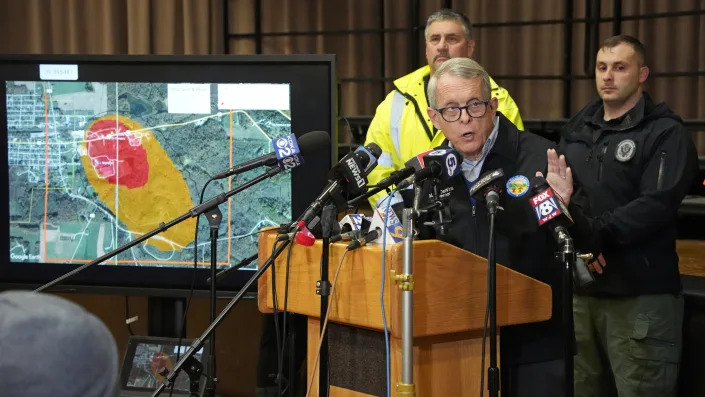
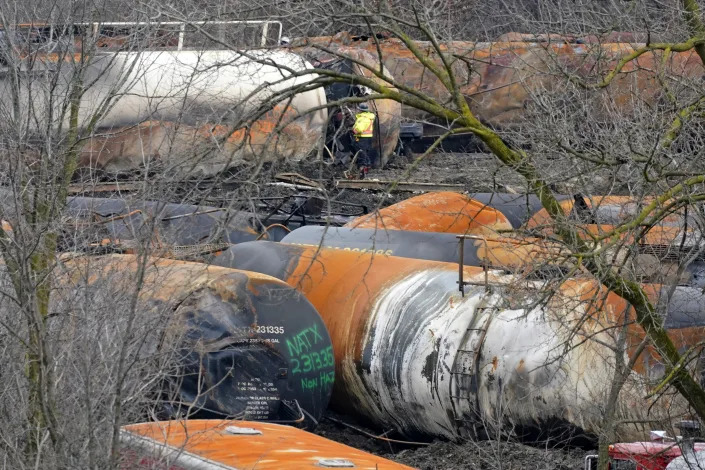
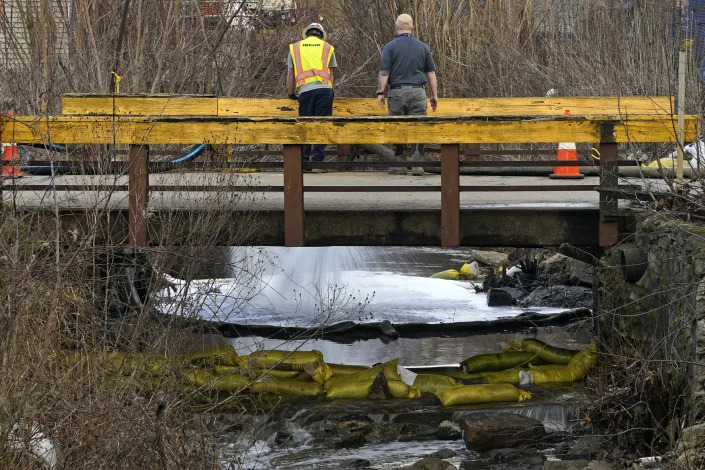
HEPACO workers, an environmental and emergency services company, observe a stream in East Palestine, Ohio, on Feb. 9, 2023, as the cleanup continues after the derailment of a Norfolk Southern freight train. Transportation Secretary Pete Buttigieg announced a package of reforms to improve safety Tuesday, Feb. 21 — two days after he warned the railroad responsible for the derailment, Norfolk Southern, to fulfill its promises to clean up the mess just outside East Palestine, and help the town recover. (AP Photo/Gene J. Puskar, File)
JOSH FUNK
Tue, February 21, 2023
OMAHA, Neb. (AP) — Transportation Secretary Pete Buttigieg wants the nation’s freight railroads to immediately act to improve safety while regulators try to strengthen safety rules in the wake of a fiery derailment in Ohio that forced evacuations when toxic chemicals were released and burned.
Buttigieg announced a package of reforms Tuesday — two days after he warned the railroad responsible for the derailment, Norfolk Southern, to fulfill its promises to clean up the mess just outside East Palestine, Ohio, and help the town recover. He said the Department of Transportation will hold the railroad accountable for any safety violations that contributed to the Feb. 3 crash near the Pennsylvania border.
“While ensuring the safety of those impacted by this crash is the immediate priority, we also have to recognize that this represents an important moment to redouble our efforts to make this far less likely to happen again in the future," Buttigieg said.
Even though government data shows that derailments have declined in recent years, there were still 1,049 of them last year.
The head of the Environmental Protection Agency plans to return to the town of 4,700 Tuesday along with the governors of Ohio and Pennsylvania to discuss the cleanup and efforts to keep people safe on the same day officials plan to open a medical clinic staffed by contamination experts to evaluate residents' complaints. State and federal officials have reiterated that their testing of air and water samples in the area doesn't show dangerous levels of any toxins, but some people have been complaining about constant headaches and irritated eyes as they worry about returning to their homes.
Buttigieg said railroads and tank car owners should take action themselves to accelerate their plan to upgrade the tank cars that haul flammable liquids like crude oil and ethanol by 2025 instead of waiting to comply with the 2029 standard Congress ultimately approved after regulators suggested the earlier deadline. He also said freight railroads should quickly agree to use a confidential hotline regulators created that lets employees report safety concerns without fear of retribution, and reach agreements to provide their employees with paid sick time to help prevent fatigue.
He also wants railroads to stop asking for waivers from inspection requirements every time they develop new technology to improve inspections, because he said the technology should supplement but not replace human inspections.
Railroad unions have also been raising concerns that car inspections are being rushed and preventative maintenance may be getting neglected after widespread job cuts in the industry in recent years that they say have made railroads riskier. Greg Regan, president of the AFL-CIO's Transportation Trades Department coalition, said Ohio's derailment should prompt reforms.
“I do think that there’s a moment to look in the mirror as an entire industry and decide what we can do better,” Regan said. “I think the industry by and large has been reluctant to make the types of changes that are needed. They have obviously fought regulations in the past, but I think they are running out of excuses here.”
Buttigieg said regulators will be looking at whether they can revive a proposed rule the Trump administration dropped that would have required upgraded, electronically-controlled brakes on certain trains filled with flammable liquids that are designated “high-hazardous flammable train.” The rule was dropped after Congress directed regulators to use a strict cost-benefit analysis to evaluate the rule and they decided the potential benefits couldn't justify the costs.
Buttigieg said he'll ask Congress to “untie our hands here” on the braking rule, and regulators may look at expanding which trains are covered by the “high-hazardous” rules that were announced in 2015 after several fiery crude oil train derailments — the worst of which killed 47 people and decimated the Canadian town of Lac Mégantic in 2013. He also said Congress should raise the current $225,455 limit on railroad safety fines at least tenfold to create a better deterrent for the multibillion-dollar corporations.
Buttigieg criticized railroads for lobbying against the braking rule and challenging it in court. But railroad safety expert David Clarke, who previously led the Center for Transportation Research at the University of Tennessee, said the industry shouldn’t be criticized too heavily for pushing back against proposed regulations when there are questions about their benefits.
“The fact that you couch those in terms of safety makes it seem like it’s, you know, mom, God and apple pie — anything safety related is sacred,” Clarke said. “But the bottom line is companies have to look at the benefits and the cost of any expenditure.”
Ohio Gov. Mike DeWine was incredulous when he learned the Norfolk Southern train that derailed didn’t carry that designation, meaning that the railroad didn’t have to notify the state about the dangerous chemicals it was carrying or follow detailed requirements about finding the safest route for those chemicals.
“This is absurd,” DeWine said. “Congress needs to take a look at how this is handled.”
Regulators and the Association of American Railroads trade group say there are hundreds of pages of other rules railroads must follow when they transport any hazardous chemicals, whether it is the vinyl chloride that has gotten so much attention in this derailment, crude oil, nuclear materials or any of the hundreds of other dangerous chemicals that railroads routinely carry.
It’s not clear whether the “high-hazardous” rules could have prevented this derailment. The federal National Transportation Safety Board is in the early stages of its investigation, although officials with that agency have said they believe the failure of an axle on one of the railcars not long after the train crew got a warning about a possible mechanical problem caused this crash.
The Federal Railroad Administration will also work to finalize its proposed rule to require two-person crews in most circumstances that Buttigieg pointed to as one of the Biden administration's main efforts to improve rail safety over the past two years.
The president of the Brotherhood of Locomotive Engineers and Trainmen, Eddie Hall, said he believes the freight railroads' efforts to cut crews down to one person represent a clear threat to safety.
“Railroads in the United States largely self-regulate, and right now, rather than learn from their mistakes and improve oversight and safety, they are going in the opposite direction,” Hall said. “We welcome efforts by the Department of Transportation to improve rail safety.”
Norfolk Southern officials declined to respond directly to Buttigieg on Monday other than to reiterate the railroad’s commitment to safety and to cleaning up the derailment. CEO Alan Shaw said in a statement the railroad reissued Monday that he knows the railroad will be judged by its actions, but he pledged to do everything he could to help “get East Palestine back on its feet as soon as possible.”
As part of those efforts, the railroad said it has designated one of its local employees who lives in the town as a liaison between East Palestine and Norfolk Southern. That person will oversee a $1 million budget to help the community in addition a $1 million fund the railroad created to help residents and $3.4 million in payments it has already handed out to families. Those payments are likely just the start, as the EPA has said Norfolk Southern will be responsible for the cleanup costs and several lawsuits have already been filed against the railroad.
University of Illinois professor Christopher Barkan, who teaches a class on railroad operating safety and advises the industry on tank car safety standards and environmental concerns, said he believes the railroad will follow through.
“I haven’t the slightest doubt that Norfolk Southern is going to be responsive, and continue to be responsive. until all of the environmental problems have been addressed,” Barkan said. “I understand why the people in that town are really concerned right now. It’s a horrible thing to have happen in your town.”
Buttigieg urges U.S. railroads to boost safety, not oppose reforms

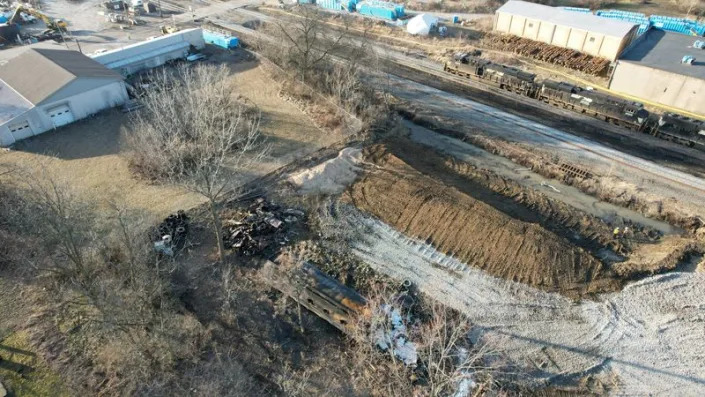
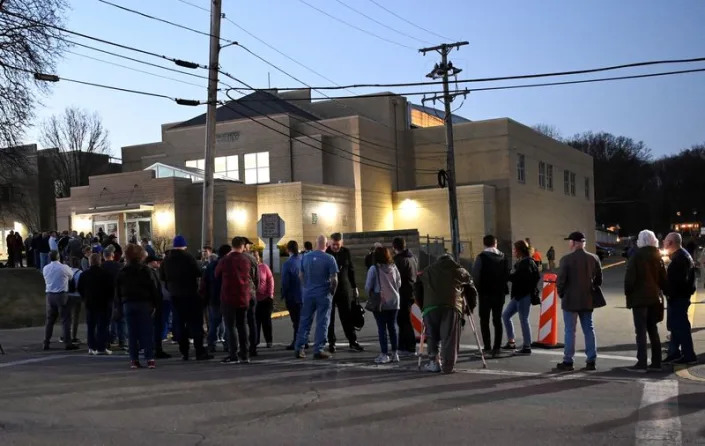


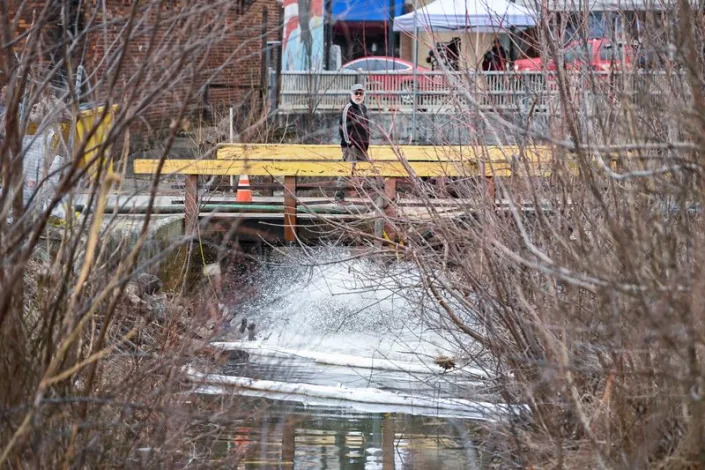
Members of the U.S. Environmental Protection Agency (EPA) inspect the site of a train derailment of hazardous material in East Palestine
Sun, February 19, 2023 By David Shepardson
(Reuters) -U.S. Transportation Secretary Pete Buttigieg said Sunday he would call on major railroads to improve safety after a Feb. 3 derailment in East Palestine, Ohio, of a train operated by Norfolk Southern.
Buttigieg in a letter to Norfolk Southern Chief Executive Alan Shaw said he would also urge Congress to raise the cap on fines against railroads for violating safety regulations "to ensure their deterrent effect is commensurate with the economic proportions of today's large railroad companies."
Buttigieg said he would soon outline specific safety improvements railroads should take immediately. He harshly criticized them for lobbying against steps "intended to improve rail safety and to help keep Americans safe."
"Major derailments in the past have been followed by calls for reform – and by vigorous resistance by your industry to increased safety measures. This must change," Buttigieg wrote.
Buttigieg has faced harsh criticism from many Republicans in Congress for his response to the derailment of the train loaded with toxic chemicals that caused a fire and sent a cloud of smoke over the town that forced thousands of residents to evacuate while railroad crews drained and burned off chemicals.
No fatalities or injuries have been reported, but residents have been demanding answers about potential health risks.
Buttigieg's letter emphasized "the urgent need for Norfolk Southern to demonstrate unequivocal support for the people of East Palestine and the surrounding areas."
Norfolk Southern said Sunday it "received a copy of the letter from the secretary and are reviewing." Shaw said last week the railroad had established an initial $1 million community support fund and distributed $1.7 million in direct financial assistance to more than 1,100 families and businesses to cover evacuation costs.
"We will not let you down," he told residents in a letter.
Buttigieg's letter said that in response to many derailments, two U.S. agencies had finalized rules on high-hazard flammable trains and Electronically Controlled Pneumatic (ECP) braking.
"Rather than support these efforts to improve rail safety, Norfolk Southern and other rail companies spent millions of dollars in the courts and lobbying members of Congress to oppose common-sense safety regulations, stopping some entirely and reducing the scope of others," Buttigieg wrote.
"As a result, Congress enacted language that undermined the ability of USDOT to sustain the ECP brake requirements, and they were ultimately withdrawn under the Trump administration."
Buttigieg said he also planned to outline "prioritized actions planned" by the U.S. Department of Transportation on rail safety.
In response to the derailment, U.S. Senate Commerce Committee Chair Maria Cantwell Friday opened an inquiry into railroad hazardous materials safety practices.
The Senate Environment and Public Works Committee said Friday it planned to hold a hearing on the derailment.
In a letter to Shaw and CEOs of major railroad companies, Cantwell said "every railroad must reexamine its hazardous materials safety practices to better protect its employees, the environment, and American families and reaffirm safety as a top priority."
The companies included Berkshire Hathaway's Burlington Northern Santa Fe (BNSF), Canadian National, Canadian Pacific, CSX, Kansas City Southern and Union Pacific.
A group representing major railroads said last week 99.9% of all hazmat shipments reach their destination without incident and the hazmat accident rate has declined by 55% since 2012.
(Reporting by David Shepardson in Franconia, New Hampshire; Editing by Lisa Shumaker, Richard Chang and Diane Craft)
A GOP senator says Republican lawmakers are frustrated with Transportation Secretary Pete Buttigieg because he wants 'everything to be climate and politically correct'
John L. Dorman
Sun, February 19, 2023

West Virginia Sen. Shelley Moore Capito has raised concerns about Pete Buttigieg's tenure as Transportation secretary.
AP Photo/Manuel Balce Ceneta
Hill Republicans are increasingly voicing their issues with Transportation Secretary Pete Buttigieg.
Sen. Capito told The Hill that Buttigieg had a "push" for everything "to be climate and politically correct."
The Department of Transportation has defended Buttigieg's performance in handling recent crises.
Transportation Secretary Pete Buttigieg has made it his mission to champion President Joe Biden's bipartisan infrastructure law, traveling to various sites across the country to tout major projects that have gotten off the ground thanks to the legislation.
But he has also had to tackle an array of major crises, including a Southwest Airlines system meltdown that affected roughly 2 million travelers in late December, a Federal Aviation Administration system outage that wreaked havoc on flights in January, and a February train derailment in East Palestine, Ohio, that resulted in the release of toxic chemicals into the air.
Buttigieg has sought to reassure Americans that his department is working closely with officials and lawmakers regarding each of the respective incidents, but many Republicans in Congress have so far not been enthralled with his job performance. The GOP lawmakers have expressed dismay with what they say is outreach that is insufficient compared to other members of Biden's cabinet.
Sen. Shelley Moore Capito of West Virginia, who represents a state with vast rural expanses and critical infrastructure needs, told The Hill that Buttigieg's "philosophical push for everything to be climate and politically correct" is at the center of issues that Republican lawmakers have raised.
"We have practical matters we need to do like permitting and building new roads and having new constructions and he pretty much puts his foot down on a lot of that stuff," she told the publication. "He's just not leading and I think that's the frustration."
Senate Minority Whip John Thune of South Dakota told The Hill that Buttigieg's management style wasn't as "hands on" as other Biden officials.
"My sense is that he, like many others in the administration, are not the types of, sort of, hands on managers that you need at a time like that," the senator said. "I think part of it too is just the efforts he makes. … Some members of the cabinet, particularly on the relevant committees, the committees of jurisdiction, do a really good job of outreach and I don't get that from him."
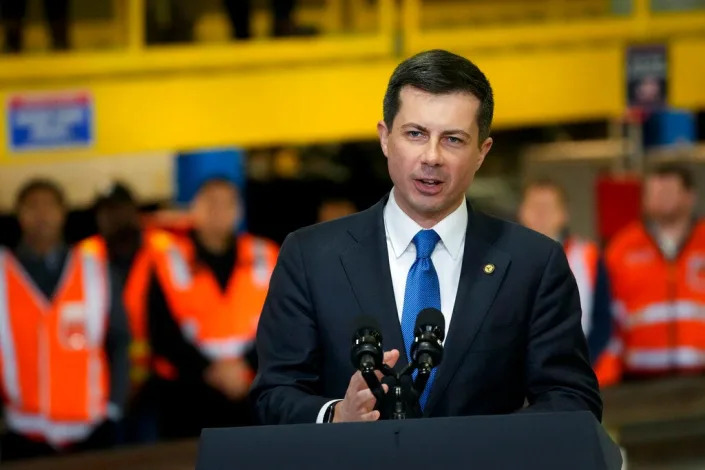
Secretary Buttigieg has been a vocal champion of President Biden's bipartisan infrastructure law.
Hill Republicans are increasingly voicing their issues with Transportation Secretary Pete Buttigieg.
Sen. Capito told The Hill that Buttigieg had a "push" for everything "to be climate and politically correct."
The Department of Transportation has defended Buttigieg's performance in handling recent crises.
Transportation Secretary Pete Buttigieg has made it his mission to champion President Joe Biden's bipartisan infrastructure law, traveling to various sites across the country to tout major projects that have gotten off the ground thanks to the legislation.
But he has also had to tackle an array of major crises, including a Southwest Airlines system meltdown that affected roughly 2 million travelers in late December, a Federal Aviation Administration system outage that wreaked havoc on flights in January, and a February train derailment in East Palestine, Ohio, that resulted in the release of toxic chemicals into the air.
Buttigieg has sought to reassure Americans that his department is working closely with officials and lawmakers regarding each of the respective incidents, but many Republicans in Congress have so far not been enthralled with his job performance. The GOP lawmakers have expressed dismay with what they say is outreach that is insufficient compared to other members of Biden's cabinet.
Sen. Shelley Moore Capito of West Virginia, who represents a state with vast rural expanses and critical infrastructure needs, told The Hill that Buttigieg's "philosophical push for everything to be climate and politically correct" is at the center of issues that Republican lawmakers have raised.
"We have practical matters we need to do like permitting and building new roads and having new constructions and he pretty much puts his foot down on a lot of that stuff," she told the publication. "He's just not leading and I think that's the frustration."
Senate Minority Whip John Thune of South Dakota told The Hill that Buttigieg's management style wasn't as "hands on" as other Biden officials.
"My sense is that he, like many others in the administration, are not the types of, sort of, hands on managers that you need at a time like that," the senator said. "I think part of it too is just the efforts he makes. … Some members of the cabinet, particularly on the relevant committees, the committees of jurisdiction, do a really good job of outreach and I don't get that from him."

Secretary Buttigieg has been a vocal champion of President Biden's bipartisan infrastructure law.
AP Photo/John Minchillo
Other Republican lawmakers, notably Sen. Ted Cruz of Texas, have been critical of Buttigieg for what they've said was his lack of visibility immediately after the East Palestine derailment.
"I understand that the secretary is politically ambitious, and he'd like to move to government housing in Washington right up the street, but he does have a job to do," Cruz told reporters last week, referencing the expectation that Buttigieg will run for the presidency again someday. (Buttigieg ran for president in 2020 and performed strongly in Iowa and New Hampshire before faltering in South Carolina and exiting the race.)
Rep. Warren Davidson of Ohio during a recent appearance on the Real America's Voice suggested impeaching Buttigieg over his response to the train derailment.
"I hope he does resign, and if he doesn't, there's a long list of impeachment criteria," Davidson told the outlet.
Democrats contend that the criticism of Buttigieg is purely political.
"Before, if you got your flight delayed, you weren't like 'oh that damn Elaine Chao,'" a Democratic operative told The Hill, referring to former President Donald Trump's transportation secretary. "That's the downside that comes with being such a good public figure."
The Department of Transportation has stood by its response as it works with the National Transportation Safety Board (NTSB) and the Environmental Protection Agency, remarking that the department and staffers "were on the ground hours after the derailment" to aid the NTSB in their investigation.
"It's no surprise to see some playing politics with every crisis, even something as serious as the impacts of a global pandemic on our transportation systems or a train derailment," a Department of Transportation spokesperson said in a statement, adding that the secretary was maintaining a "focus on getting results."
Other Republican lawmakers, notably Sen. Ted Cruz of Texas, have been critical of Buttigieg for what they've said was his lack of visibility immediately after the East Palestine derailment.
"I understand that the secretary is politically ambitious, and he'd like to move to government housing in Washington right up the street, but he does have a job to do," Cruz told reporters last week, referencing the expectation that Buttigieg will run for the presidency again someday. (Buttigieg ran for president in 2020 and performed strongly in Iowa and New Hampshire before faltering in South Carolina and exiting the race.)
Rep. Warren Davidson of Ohio during a recent appearance on the Real America's Voice suggested impeaching Buttigieg over his response to the train derailment.
"I hope he does resign, and if he doesn't, there's a long list of impeachment criteria," Davidson told the outlet.
Democrats contend that the criticism of Buttigieg is purely political.
"Before, if you got your flight delayed, you weren't like 'oh that damn Elaine Chao,'" a Democratic operative told The Hill, referring to former President Donald Trump's transportation secretary. "That's the downside that comes with being such a good public figure."
The Department of Transportation has stood by its response as it works with the National Transportation Safety Board (NTSB) and the Environmental Protection Agency, remarking that the department and staffers "were on the ground hours after the derailment" to aid the NTSB in their investigation.
"It's no surprise to see some playing politics with every crisis, even something as serious as the impacts of a global pandemic on our transportation systems or a train derailment," a Department of Transportation spokesperson said in a statement, adding that the secretary was maintaining a "focus on getting results."
